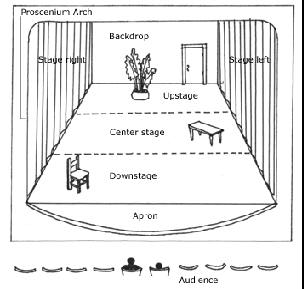
Cast of Characters Lesson Plan: The Canvas as a Stage
Illinois State Board of Education Goals and Standards:
Fine Arts Goal 25: Know the Language of the Arts
Standard A: Understand the sensory elements, organizational principles, and expressive qualities of
the arts.
Late Elementary: 25.A.2d: identify and describe the elements of 2- and 3-dimensional space,
figure-ground, value and form,.....
Purpose:
To help students understand how artists use pictorial space by examining the theatrical
stage as a metaphor for one way that painters organize two-dimensional space to give the illusion of
three dimensions.
Objective:
After viewing the three paintings on the theme "The World as a Stage", students will
create a painting using the theatrical stage as a basis for their composition and
interpretation of subject matter.
Grade Levels: 5-7
Time Required: two 50-minute periods
Materials:
The choice of medium will be the teachers
or the students, according to circumstances
and experience:
Suggestions:
pencil, 9" x 12"
sketch paper; 12" x 18"
painting paper,
watercolor or acrylic paints,
brushes, paper pallettes,
water in cups,
paper towels.
Motivation:
Discuss the different parts of a stage and how they look. The students will be composing a painting
in which the background consists of a backdrop or curtain, or a stand-in for one.
The middle- and foregrounds will be the stage for the characters and props that tell the story. The
lighting, color, and placement will set the mood.
Remember that the picture plane is that imaginary plane across which the curtains would be drawn
on a theater stage. This curtain is sometimes called the fourth wall.
The students can brainstorm to create a short list of stories, incidents, events, dreams, or memories
in their lives or imaginations to choose one each would like to depict as if they were on a stage set.
There should be characters and objects in a place or objects that symbolize characters. Talk about
the various parts of a theater and the roles of people such as the producer, director, stage manager,
actor, and audience, and where they are placed on and about the stage.
Consider the atmosphere, lighting, makeup, costumes, set, backdrop, and curtain. Where are the
viewers -- on stage, back stage, in the balcony? What is acting like a backdrop or a curtain? Do you
have to have all the parts of a stage, or can you use just a few?
Procedure:
Sketch several compositions for the painting, keeping in mind the main characters, the audience
viewing them, and the props or stage furniture. Choose the sketch you like best and tansfer it onto
the final paper/canvas. Paint the picture.
Publication and Closure:
Hang the paintings in the classroom or elsewhere. Students should write labels with
the title, artist's name, and medium. Students relate how they expressed their ideas
in a painting using the concept of the stage.
Assessment:
Assessment is based on the presence of the characters and props on a stage for-mat with a backdrop.
As students talk about their paintings, they should use the newly acquired vocabulary.
Vocabulary:
foreground
middleground
background
backdrop or scenery
curtain
stage left and right
upstage
downstage
center stage
